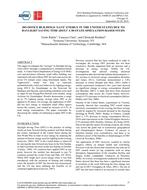Click here to purchase
This paper investigates the “savings” in Daylight SavingTime (DST) through a comprehensive simulation-basedstudy. A United States Department of Energy (US DOE)core and perimeter reference small office building wassimulated with and without DST for each state across theseven US climate zones using benchmark inputs. The“lightswitch” model was used to representprobabilistically-valid user behavior for lighting energy,using DIVA for Grasshopper as the front-end forRadiance and Daysim, and resulting schedules were usedas input for the EnergyPlus thermal zone models, usingArchsim for Grasshopper. Results demonstrate a rangeup to 7% lighting energy savings when DST is notapplied in 36 states. On average, the application of DSTdid not save energy in simulated small office spacesacross the country, and caused an increase of 0.1% intotal energy consumption. The paper concludes bydiscussing the validity of continuing to apply DST in theUS.
Citation: ASHRAE/IBPSA-USA Bldg Simulation Conf, Sept 2018
Product Details
- Published:
- 2018
- Number of Pages:
- 8
- Units of Measure:
- Dual
- File Size:
- 1 file , 2.6 MB
- Product Code(s):
- D-BSC18-C004
